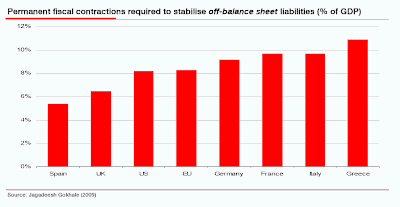The end of Lehman marked the death of securitization as we knew it, and the markets took a good six months to adjust to this new reality. But today, the Greek events mark the death of another pillar of the bull market: the idea that country risk can be safely discarded, at least in developed markets. And this could prove to be just as momentous an event.
Dylan Grice, the strategist at Societe Generale, goes further today with a basic math to explain the possibility of "to be just as momentous an event":
... maintaining a stable debt to GDP ratio requires governments to run a primary balance proportionate to the difference between interest rates and GDP growth.
Before seeing how our governments compare, two qualifications are necessary. Firstly, the European estimates are distorted by the recent "convergence" within the eurozone which allowed periphery economies temporarily higher GDP growth rates and lower interest rates. This makes on-balance sheet debt loads appear more stable for those economies than they actually are. Secondly, the calculations
show only those surpluses required to stabilise the debt loads which are on-balance sheet. And it's important to be clear about this. According to Gokhale [“Measuring the unfunded obligations of European Countries” by Jagadeesh Gokhale; National Center for Policy Analysis Policy Report 319; Jan 2009], most government indebtedness is in the form of unfunded pension and health liabilities, which are unrecorded and effectively off-balance sheet ...
Click on chart to enlarge, courtesy of Societe Generale.

Those on the left have been running budget balances consistent with falling on-balance sheet debt to GDP ratios, while those on the right haven’t. The US, the UK, Greece, Portugal and Norway (?) all fall into this latter category.
Eyeballing this chart, one might think governments ‘only’ need a 3% underlying contraction of fiscal policy in order to right the ship. Wouldn’t doing that over a number of years be plausible? Perhaps, but I can’t find any examples of it having happened before. And while that doesn’t make it impossible it does illustrate both the political difficulty of following such a path, and the behavioural biases present in politicians’ confidence that they will - if it is difficult to summon the political courage today, why will it be easier tomorrow?
But consider this: all countries, and especially those to the right in the chart, are enjoying exceptionally favourable financing positions, with government bond yields near unprecedented lows. Should anything push bond yields higher, even by just a percentage point, the on-balance sheet debt situation will become explosive. This is the situation in Japan where the 8% contraction required to rein in its already explosive debt ratio is politically impossible. And again, remember that the estimated 8% required contraction assumes the Japanese government can continue to fund itself at a 1.4% JGB yield, which is clearly unrealistic.If the on-balance sheet position today looks dicey for the rest of us, the off-balance
sheet numbers are far more worrying. The following chart shows Gokhale’s estimates of the perpetuity surpluses governments would have to run to meet the current outstanding obligations which are both on- and off-balance sheet. The chart speaks for itself. Such fiscal deflation is clearly a political impossibility.
Click on chart to enlarge, courtesy of Societe Generale.
 And he finalizes with an elegant warning to Keynesians:
And he finalizes with an elegant warning to Keynesians:Apparently heroine addicts can become so drug dependent their bodies cannot withstand the shock of withdrawal, and failure to continue taking the drug triggers multiple organ failures. I just wonder how apt that analogy is to our governments’ debt dependency today. As long as governments think that taking these difficult decisions to end the addiction will be easier in the future than it is today, they will never take the decision ‘today.’ At the very least, there will have to be a sufficiently large bond market ‘event’ to force the issue.
Keynesians have much more issues to re-consider, including the ones related to structural shifts in the incomes and taxes ...
No comments:
Post a Comment